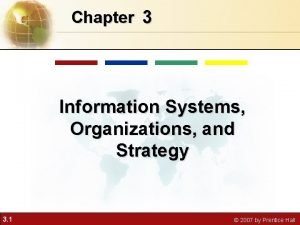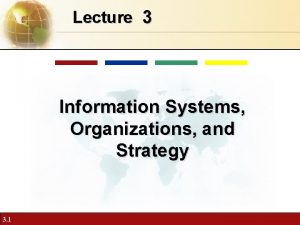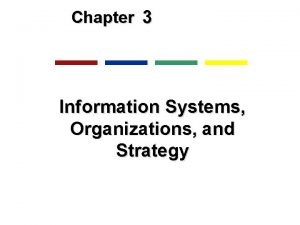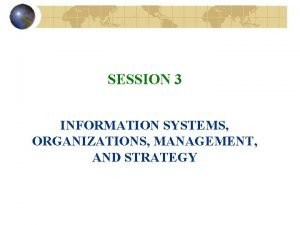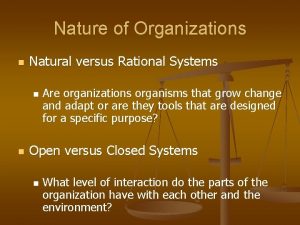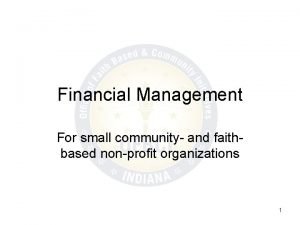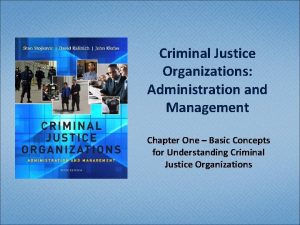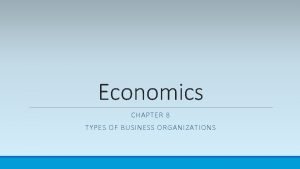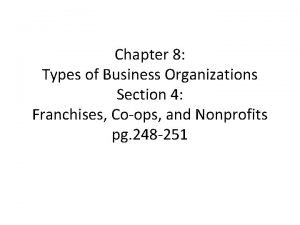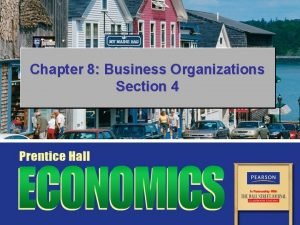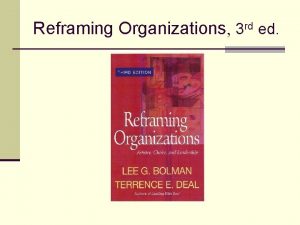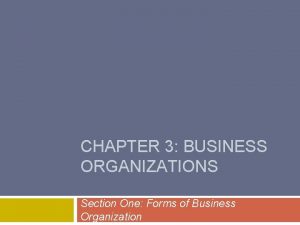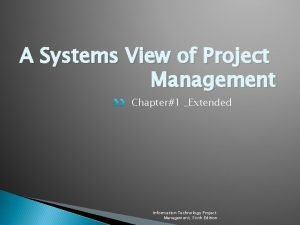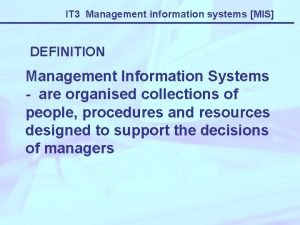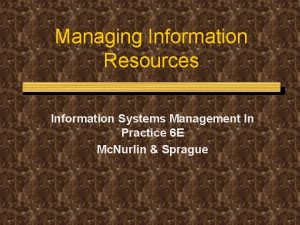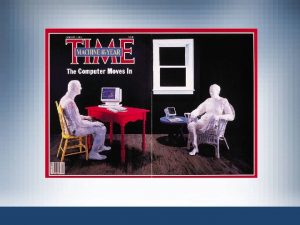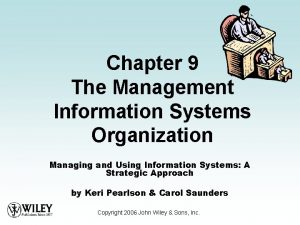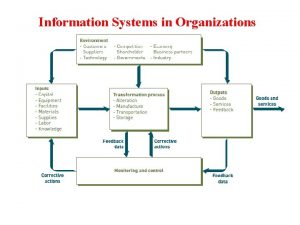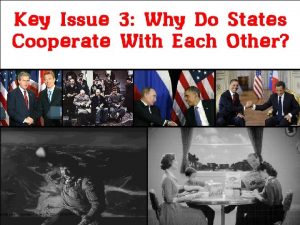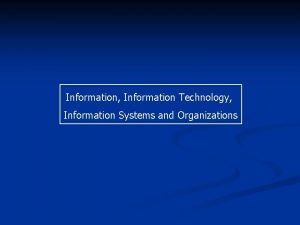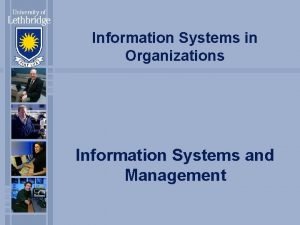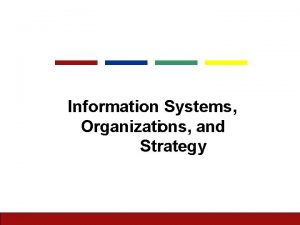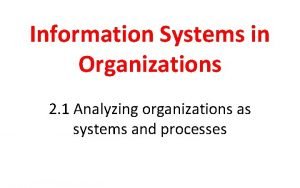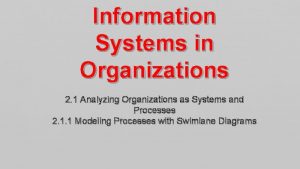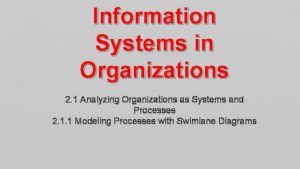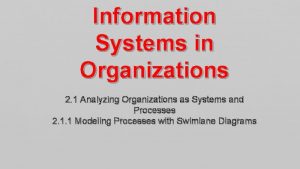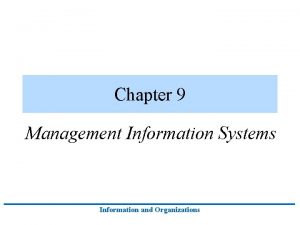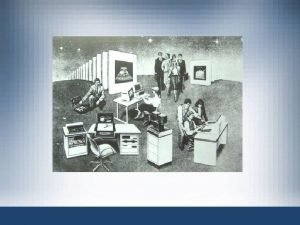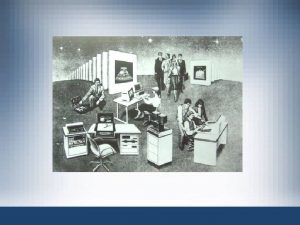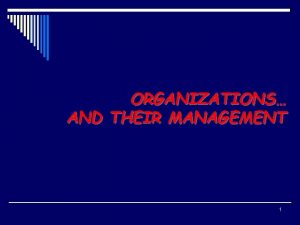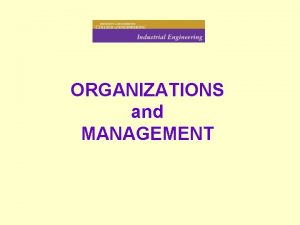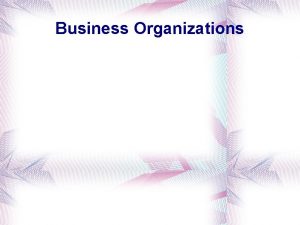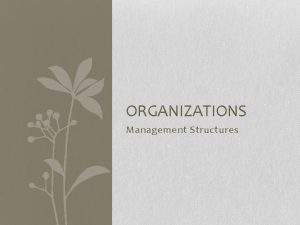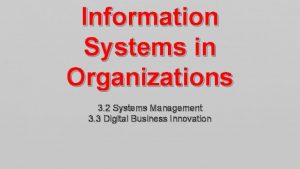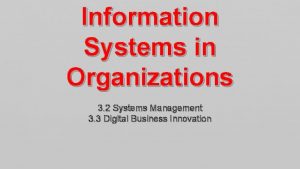Management Information Systems Chapter Three Information Systems Organizations
























- Slides: 24

Management Information Systems Chapter Three Information Systems, Organizations, and Strategy Md. Golam Kibria Lecturer & Coordinator Southeast University

What is an Organization? q Technical definition: n Stable, formal social structure that takes resources from environment and processes them to produce outputs In the microeconomic definition of organizations, capital and labor (the primary production factors provided by the environment) are transformed by the firm through the production process into products and services (outputs to the environment). The products and services are consumed by the environment, which supplies additional capital and labor as inputs in the feedback loop.

q Behavioral definition: n A collection of rights, privileges, obligations, and responsibilities that is delicately balanced over a period of time through conflict and conflict resolution

Organizations and Information Systems n Information technology and organizations influence one another This complex two-way relationship is mediated by many factors, not the least of which are the decisions made—or not made—by managers. Other factors mediating the relationship include the organizational culture, structure, politics, business processes, and environment.

Features of Organizations q q q Routines and Business Processes Organizational Politics Organizational Culture Organizational Environments Organizational Structure

• Routines and business processes • Routines (standard operating procedures) • Precise rules, procedures, and practices developed to cope with virtually all expected situations • Business processes: Collections of routines • Business firm: Collection of business processes


• Organizational politics • Divergent viewpoints lead to political struggle, competition, and conflict • Political resistance greatly hampers organizational change

• Organizational culture: q q Encompasses set of assumptions that define goal and product q What products the organization should produce q How and where it should be produced q For whom the products should be produced May be powerful unifying force as well as restraint on change

q Organizational environments: q Organizations and environments have a reciprocal relationship q Organizations are open to, and dependent on, the social and physical environment q Organizations can influence their environments q Environments generally change faster than organizations q Information systems can be an instrument of environmental scanning, act as a lens

n organizational structure n Entrepreneurial: q n Machine bureaucracy: q n Fortune 500 firms Professional bureaucracy: q n Midsize manufacturing firm Divisionalized bureaucracy: q n Small start-up business Law firms, school systems, hospitals Adhocracy: q Consulting firms

How Information Systems Impact Organizations and Business Firms n Economic impacts q Transaction cost theory n n Firms seek to economize on transaction costs (the costs of participating in markets) q Vertical integration, hiring more employees, buying suppliers and distributors IT lowers market transaction costs for a firm, making it worthwhile for firms to transact with other firms rather than grow the number of employees

Firms traditionally grew in size to reduce market transaction costs. IT potentially reduces the firms market transaction costs. This means firms can outsource work using the market, reduce their employee head count and still grow revenues, relying more on outsourcing firms and external contractors.

How Information Systems Impact Organizations and Business Firms q Agency theory: n Firm is nexus of contracts among self-interested parties requiring supervision n Firms experience agency costs (the cost of managing and supervising) which rise as firm grows n IT can reduce agency costs, making it possible for firms to grow without adding to the costs of supervising, and without adding employees

How Information Systems Impact Organizations and Business Firms n Organizational and behavioral impacts q q IT flattens organizations n Decision making pushed to lower levels n Fewer managers needed (IT enables faster decision making and increases span of control) Postindustrial organizations n Organizations flatten because in postindustrial societies, authority increasingly relies on knowledge and competence rather than formal positions

Information systems can reduce the number of levels in an organization by providing managers with information to supervise larger numbers of workers and by giving lowerlevel employees more decision-making authority.

q Organizational resistance to change n Information systems become bound up in organizational politics because they influence access to a key resource – information n Information systems potentially change an organization’s structure, culture, politics, and work n Most common reason for failure of large projects is due to organizational and political resistance to change

Using Information Systems to Achieve Competitive Advantage n Michael Porter’s competitive forces model n n Provides general view of firm, its competitors, and environment Five competitive forces shape fate of firm q q q Traditional competitors New market entrants Substitute products and services Customers Suppliers


n n Traditional competitors n All firms share market space with competitors who are continuously devising new products, services, efficiencies, switching costs New market entrants n Some industries have high barriers to entry, e. g. computer chip business n New companies have new equipment, younger workers, but little brand recognition

n n n Substitute products and services q Substitutes customers might use if your prices become too high, e. g. i. Tunes substitutes for CDs Customers q Can customers easily switch to competitor’s products? Can they force businesses to compete on price alone in transparent marketplace? Suppliers q Market power of suppliers when firm cannot raise prices as fast as suppliers

n Four generic strategies for dealing with competitive forces, enabled by using IT n n Low-cost leadership Product differentiation Focus on market niche Strengthen customer and supplier intimacy

n Low-cost leadership n n n Produce products and services at a lower price than competitors while enhancing quality and level of service Examples: Wal-Mart Product differentiation n n Enable new products or services, greatly change customer convenience and experience Examples: Google, Nike, Apple

n Focus on market niche n n n Use information systems to enable a focused strategy on a single market niche; specialize Example: Hilton Hotels Strengthen customer and supplier intimacy n n Use information systems to develop strong ties and loyalty with customers and suppliers; increase switching costs Example: Netflix, Amazon
 Chapter 3 information systems organizations and strategy
Chapter 3 information systems organizations and strategy Information systems, organizations, and strategy
Information systems, organizations, and strategy Information systems, organizations, and strategy
Information systems, organizations, and strategy Information systems, organizations, and strategy
Information systems, organizations, and strategy Information systems organizations and strategy
Information systems organizations and strategy Chapter 1 introduction to management
Chapter 1 introduction to management Three types of business
Three types of business Natural organization
Natural organization System chapter 1
System chapter 1 Introduction to management information system
Introduction to management information system Faith based financial management software
Faith based financial management software Management in criminal justice organizations
Management in criminal justice organizations Chapter 8 types of business organizations
Chapter 8 types of business organizations Section 4 other organizations
Section 4 other organizations Chapter 8 business organizations
Chapter 8 business organizations Reframing organizations chapter 3 summary
Reframing organizations chapter 3 summary Chapter 3 business organizations
Chapter 3 business organizations Three sphere model for systems management
Three sphere model for systems management Example of middle level management
Example of middle level management Definition of information system
Definition of information system Information systems management in practice
Information systems management in practice Vertical
Vertical Specialized information systems
Specialized information systems Management information systems wiley
Management information systems wiley Voyage estimating decision support system
Voyage estimating decision support system

